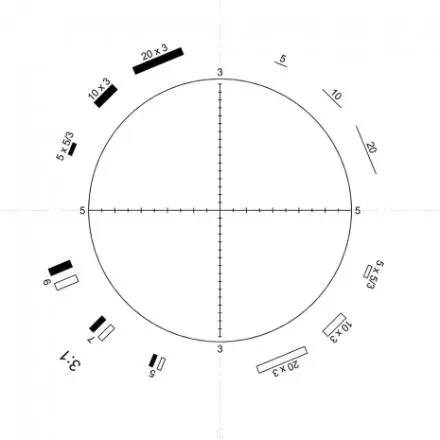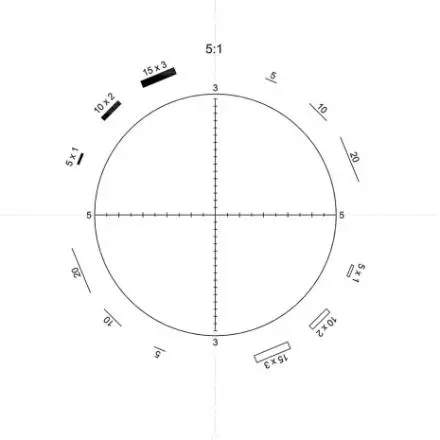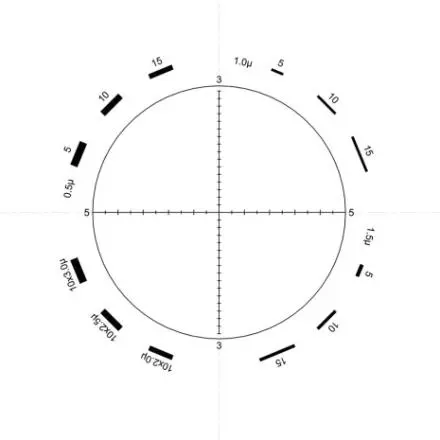目鏡刻劃片 | 石棉分析 | Asbestos Fiber Analysis
產品介紹
INTRODUCTION >> Microscope Eyepiece ReticlesWhat is Asbestos?
Asbestos are natural mineral substances (silicate minerals) resistant to heat, electricity and chemical corrosion. It has been generally used in construction materials due to their insulating and heat resistance characteristics. Asbestos fibres are highly toxic and have been proven dangerous for health causing diseases in the long term. For this reason, more than 50 countries worldwide have banned the use of asbestos.
According to HSE statistics, Asbestos still kills around 5,000 workers every year in the UK. Asbestos remains a big issue as it will be likely present in any home or building built or refurbished before the year 2000. Asbestos becomes dangerous when fibres are released once materials are damaged or disturbed.
Under the Control of Asbestos Regulations 2012 (Following EU Directive 2009/148/EC), there is a responsibility to identify and risk assess the presence of asbestos type and condition in buildings as any maintenance work would require either a licensed contractor or trained workers under controlled requirements.
There are several laboratories specialised in asbestos analysis that will be solicited for sample analysis, risk assessments, project management, training, etc.
Walton and Beckett Eyepiece Graticules
When counting asbestos samples, it has been found that limiting the area of evaluation to that defined by the grid on an eyepiece graticule can give significantly higher operator concentration values than when the full field of view of the microscope is used.
The published work by S T Beckett et al in 1976 recommended that the graticule grid method of counting be adopted for asbestos analysis and that steps be taken to reach national or, preferably, international agreement on a standard form of graticule. The Walton and Beckett graticule was designed specifically for the evaluation of fibrous dust and was adopted worldwide.
The Walton and Beckett graticules are used for counting fibrous dust and are particularly useful where the majority of fibres to be counted are shorter than 5 microns. The circle is divided into four by two diametrical lines scaled in units of 3 and 5 microns. 3 and 5 microns are the critical measurements of fibre lengths and diameter used in fibre counting. Unlike the usual globes of other particle graticules, the Walton and Beckett has a series of shapes to compare objects with. These shapes have been designed for comparison with fibres, especially since they incorporate aspect ratios of 3:1 (G22) or 5:1 (G24) essential for such analysis. Based on the G22, the G25 is produced to a new design by the Institute of Occupational Health in 1996.
Calibration Factors for Walton and Beckett Graticules
The circle on the Walton and Beckett graticule must represent 100 microns at the stage of the microscope when used with a 40x objective lens. The microscope needs to be calibrated to ensure that the Walton and Beckett graticule will give true measurements when it is fitted – see example below.
Calculating the Calibration Factor
First calibrate your instrument with an eyepiece scale (NE1 for example) and the appropriate stage micrometer (PS12).
Example - Using a 40X objective, a circle in the eyepiece requires a diameter of 4000 microns (4mm) to coincide with or read a 100 micron circle at the stage. The calibration factor is then defined as 4.
Calibration Factor or D Value = (Actual Length in mm on the reticle X 100) / Magnified Length in um
Example: (4mm x 100) / 100 = 4
Walton and Beckett Graticule for Asbestos — G22, G24, G25
Calibration factors are required for each of these graticules. See note below.
The Walton and Beckett graticule is used for counting fibrous dust (e.g. asbestos or glass fibers) and is particularly useful where the majority of fibers to be counted are shorter than 5 microns. The circle is divided into four by two diametrical lines scaled in units of 5 and 3 microns respectively. 3 and 5 microns are the critical measurements of fiber lengths and diameters used in fiber counting. Unlike the usual globes of other particle graticules, the Walton and Beckett have a series of shapes to compare objects with. These shapes have been designed for comparison with fibers, especially since they incorporate an aspect ratio of 3:1 or 5:1 essential for such analysis.
IMPORTANT NOTE: The circle on these Walton & Beckett graticules must represent 100 microns at the stage and each one must be manufactured to suit the individual instrument.
Therefore, the following details should be provided with your order:
1. Calibration factor, if known
2. Objective magnification
3. Eyepiece magnification
4. Diameter of graticule disc required
5. Microscope make and model
包裝樣式

產品總覽
Products >> Microscope Eyepiece Reticles

G22 Walton & Beckett 3:1
Eyepiece Reticle with Walton/Beckett for Asbestos 3-1 Ratio. All with calibration factor of 4 for use with 40x objectives.
The Walton and Beckett graticule is used for counting fibrous dust (e.g. asbestos or glass fibres) and is particularly useful where the majority of fibres to be counted are shorter than 5 micron. The circle is divided into four by two diametrical lines scaled in units of 5 and 3 microns respectively. 3 and 5 microns are the critical measurements of fibre lengths used in fibre counting. Unlike the usual globes of other particle graticules the Walton and Beckett has a series of shapes to compare objects with. These shapes have been designed for comparison with fibres, especially since they incorporate an aspect ratio of 3:1 or 5:1 essential for such analysis.
IMPORTANT NOTE. The circle on these Walton & Beckett reticles must represent 100 microns at the stage and each one must be manufactured to suit the individual instrument. Therefore, details should be provided with your order of :- Calibration factor, if known or Objective magnification, eyepiece magnification, diameter of reticle disc required, microscope make and model. All Walton & Beckett reticles are normally used with 40x objectives giving a calibration factor of 4. In some microscopes there is also an additional 1.25x magnification to give a total objective magnification of 50x - these will have a calibration factor of 5. All standard Walton & Beckett reticles are supplied with a calibration factor of 4. Other calibration factors are made to special order. These reticles will require a calibrated stage micrometer to verify the sizes - See PS12 . For phase contrast verification see also S84.

G24 Walton & Beckett 5:1
Eyepiece Reticle with Walton/Beckett for Asbestos 5-1 Ratio. All with calibration factor of 4 for use with 40x objectives.
The Walton and Beckett graticule is used for counting fibrous dust (e.g. asbestos or glass fibres) and is particularly useful where the majority of fibres to be counted are shorter than 5 micron. The circle is divided into four by two diametrical lines scaled in units of 5 and 3 microns respectively. 3 and 5 microns are the critical measurements of fibre lengths used in fibre counting. Unlike the usual globes of other particle graticules the Walton and Beckett has a series of shapes to compare objects with. These shapes have been designed for comparison with fibres, especially since they incorporate an aspect ratio of 3:1 or 5:1 essential for such analysis.
IMPORTANT NOTE. The circle on these Walton & Beckett reticles must represent 100 microns at the stage and each one must be manufactured to suit the individual instrument. Therefore, details should be provided with your order of :- Calibration factor, if known or Objective magnification, eyepiece magnification, diameter of reticle disc required, microscope make and model. All Walton & Beckett reticles are normally used with 40x objectives giving a calibration factor of 4. In some microscopes there is also an additional 1.25x magnification to give a total objective magnification of 50x - these will have a calibration factor of 5. All standard Walton & Beckett reticles are supplied with a calibration factor of 4. Other calibration factors are made to special order. These reticles will require a calibrated stage micrometer to verify the sizes - See PS12 . For phase contrast verification see also S84.

G25 Walton & Beckett 1996
Eyepiece Reticle with Walton/Beckett (1996) for Asbestos. All with calibration factor of 4 for use with 40x objectives.
Based on the G22, the G25 is produced to a new design by the Institute of Occupational Health.
IMPORTANT NOTE. The circle on these Walton & Beckett reticles must represent 100 microns at the stage and each one must be manufactured to suit the individual instrument. Therefore, details should be provided with your order of :- Calibration factor, if known or Objective magnification, eyepiece magnification, diameter of reticle disc required, microscope make and model. All Walton & Beckett reticles are normally used with 40x objectives giving a calibration factor of 4. In some microscopes there is also an additional 1.25x magnification to give a total objective magnification of 50x - these will have a calibration factor of 5. All standard Walton & Beckett reticles are supplied with a calibration factor of 4. Other calibration factors are made to special order. These reticles will require a calibrated stage micrometer to verify the sizes - See PS12 . For phase contrast verification see also S84.




